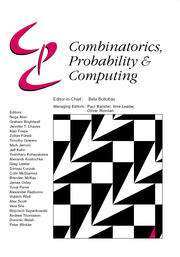Article contents
Independent dominating sets in graphs of girth five
Published online by Cambridge University Press: 15 October 2020
Abstract
Let  $\gamma(G)$ and
$\gamma(G)$ and  $${\gamma _ \circ }(G)$$ denote the sizes of a smallest dominating set and smallest independent dominating set in a graph G, respectively. One of the first results in probabilistic combinatorics is that if G is an n-vertex graph of minimum degree at least d, then
$${\gamma _ \circ }(G)$$ denote the sizes of a smallest dominating set and smallest independent dominating set in a graph G, respectively. One of the first results in probabilistic combinatorics is that if G is an n-vertex graph of minimum degree at least d, then $$\begin{equation}\gamma(G) \leq \frac{n}{d}(\log d + 1).\end{equation}$$
$$\begin{equation}\gamma(G) \leq \frac{n}{d}(\log d + 1).\end{equation}$$
In this paper the main result is that if G is any n-vertex d-regular graph of girth at least five, then $$\begin{equation}\gamma_(G) \leq \frac{n}{d}(\log d + c)\end{equation}$$
$$\begin{equation}\gamma_(G) \leq \frac{n}{d}(\log d + c)\end{equation}$$ $d \rightarrow \infty$, almost all d-regular n-vertex graphs G of girth at least five have
$d \rightarrow \infty$, almost all d-regular n-vertex graphs G of girth at least five have $$\begin{equation}\gamma_(G) \sim \frac{n}{d}\log d.\end{equation}$$
$$\begin{equation}\gamma_(G) \sim \frac{n}{d}\log d.\end{equation}$$
Furthermore, if G is a disjoint union of  ${n}/{(2d)}$ complete bipartite graphs
${n}/{(2d)}$ complete bipartite graphs  $K_{d,d}$, then
$K_{d,d}$, then  ${\gamma_\circ}(G) = \frac{n}{2}$. We also prove that there are n-vertex graphs G of minimum degree d and whose maximum degree grows not much faster than d log d such that
${\gamma_\circ}(G) = \frac{n}{2}$. We also prove that there are n-vertex graphs G of minimum degree d and whose maximum degree grows not much faster than d log d such that  ${\gamma_\circ}(G) \sim {n}/{2}$ as
${\gamma_\circ}(G) \sim {n}/{2}$ as  $d \rightarrow \infty$. Therefore both the girth and regularity conditions are required for the main result.
$d \rightarrow \infty$. Therefore both the girth and regularity conditions are required for the main result.
MSC classification
Information
- Type
- Paper
- Information
- Copyright
- © The Author(s), 2020. Published by Cambridge University Press
Footnotes
Research supported by an Alfred P. Sloan Research Fellowship and NSF grant DMS 0800704.
References
- 1
- Cited by


